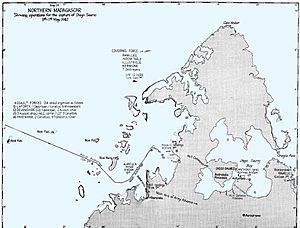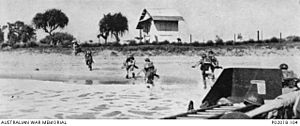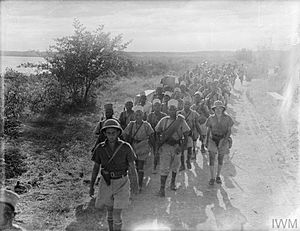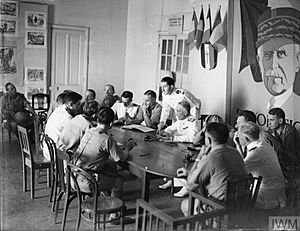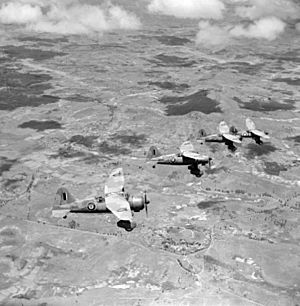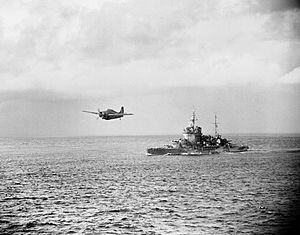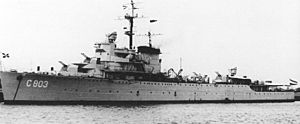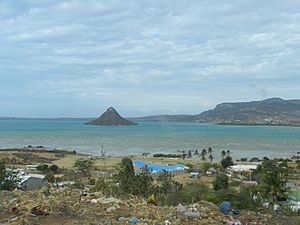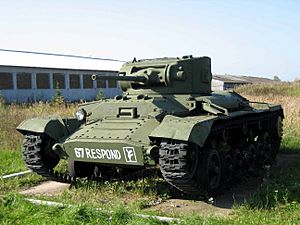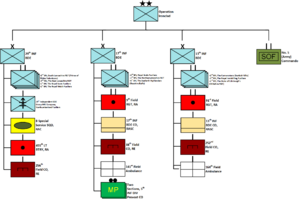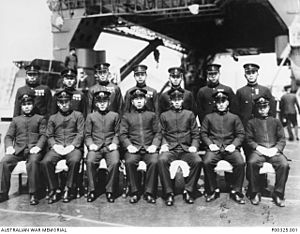Battle of Madagascar facts for kids
Quick facts for kids Battle of Madagascar |
|||||||||
|---|---|---|---|---|---|---|---|---|---|
| Part of the Indian Ocean theatre of World War II | |||||||||
 King's African Rifles' 25 pdr battery in action near Ambositra in Madagascar against Vichy positions during Operation Stream Line Jane, September 1942. |
|||||||||
|
|||||||||
| Belligerents | |||||||||
|
Naval only: |
Naval only: |
||||||||
| Commanders and leaders | |||||||||
| Strength | |||||||||
| 10,000–15,000 soldiers 6 infantry tanks 6 light tanks 2 aircraft carriers 1 seaplane carrier 2 battleships 6 light cruisers 22 destroyers 8 corvettes 1 monitor 1 minelayer 4 minesweepers 5 assault transports over 81 aircraft |
Vichy France: 8,000 soldiers 6 tanks 35 aircraft 4 warships Japanese Navy 2 soldiers 4 submarines 2 midget submarines 1 reconnaissance aircraft |
||||||||
| Casualties and losses | |||||||||
|
107 killed 620 |
152 killed 500 wounded (does not include any casualties caused by disease) 1,000 captured 34 aircraft destroyed 1 midget submarine destroyed 1 midget submarine lost at sea |
||||||||
The Battle of Madagascar was a military campaign during World War II. It took place from May to November 1942. The goal was for British and Allied forces to take control of the island of Madagascar. At the time, Madagascar was controlled by Vichy France, a French government that worked with Axis countries.
The Allies wanted to stop the Imperial Japanese Navy from using Madagascar's ports. They feared this would threaten important shipping routes to India, Australia, and Southeast Asia. The battle started with Operation Ironclad on May 5, 1942. This operation aimed to capture the port of Diego-Suarez (now Antsiranana) in the north of the island.
Later, Operation Stream Line Jane began on September 10. This was a bigger effort to secure the whole island. Allied forces moved inland and connected with troops on the coast. By the end of October, the island was under Allied control. Fighting stopped on November 6, and an agreement was signed. This battle was the first major operation where the Allies combined sea, land, and air forces. After the battle, Madagascar was placed under Free French control.
Contents
Why Madagascar Was Important
Diego-Suarez: A Key Port
Diego-Suarez is a large bay with a great harbor at the northern tip of Madagascar. It has a narrow entrance called Oronjia Pass. The naval base of Diego-Suarez is on a small piece of land within the bay. This bay was important because it was a good place for steamships to refuel. In the 1880s, France took control of the bay and nearby islands. By 1941, Diego-Suarez and its harbor were well protected by shore batteries.
The Threat from Japan
By early 1942, Japanese forces had taken over much of Southeast Asia. Their submarines were moving freely in the Indian Ocean. In March, Japanese aircraft carriers attacked merchant ships and bases in Ceylon (now Sri Lanka). This forced the British Eastern Fleet to move its base to Kilindini Harbour in Mombasa, Kenya.
This move made the British fleet more open to attack. The Allies worried that Japanese naval forces might use bases in Madagascar. Japanese submarines had a very long range, over 10,000 miles. If they could use Madagascar as a base, they could threaten Allied shipping routes across a huge area. This included routes from the Pacific to the Middle East and even the South Atlantic.
German and Japanese military leaders had discussed operations in the Indian Ocean. Germany wanted Japan to focus on attacking shipping routes there. They also wanted Japan to target Ceylon, the Seychelles, and Madagascar. Japan agreed to send submarines to the western Indian Ocean.
Allied Concerns and Plans
The Allies heard about Japan's plans for the Indian Ocean. In late 1941, British leaders discussed the possibility of Vichy France giving Madagascar to Japan. They thought about occupying the island as a safety measure. Charles de Gaulle, the leader of the Free French forces, also urged an operation against Madagascar.
Winston Churchill, the British Prime Minister, understood the danger of a Japanese-controlled Madagascar. He saw Diego-Suarez as key to Japanese power in the Indian Ocean. However, he felt Britain didn't have enough resources for such a big operation. He also didn't want a joint operation with Free French forces, remembering problems from the Battle of Dakar in 1940.
By March 1942, Churchill was convinced the operation was necessary. They decided to plan the invasion, but without the Free French. The operation was called Operation Bonus. Churchill set some guidelines:
- Force H, a naval group, would move from Gibraltar to the south.
- A force of 4,000 men would be the core of the plan.
- The operation should start around April 30, 1942.
- After success, regular troops would replace the special forces.
On March 14, Force 121 was formed under Major-General Robert Sturges. Rear-Admiral Edward Neville Syfret led the naval forces.
Preparing for Battle
Force 121 left Scotland on March 23. They met Syfret's ships in Freetown, Sierra Leone. From there, they sailed in two groups to Durban, South Africa. Here, they were joined by the 13th Brigade Group. General Sturges' force had three infantry brigades. Syfret's fleet was very strong. It included the battleship HMS Ramillies, two aircraft carriers (HMS Illustrious and HMS Indomitable), two cruisers, eleven destroyers, and many other ships. This was a powerful force to use against the 8,000 Vichy troops in Diego-Suarez. Most of these defenders were Malagasy soldiers.
This was the first British amphibious assault (landing troops from the sea) in 27 years. During the assembly in Durban, Field-Marshal Jan Smuts suggested taking other ports like Majunga and Tamatave. But due to a lack of soldiers, they decided to focus only on Diego-Suarez. Churchill said that to truly secure Madagascar, a strong fleet and air support from Ceylon were needed. He planned to hand over responsibility for Madagascar to General Archibald Wavell (India Command) after the initial goals were met.
In March and April, the South African Air Force (SAAF) flew reconnaissance missions over Diego-Suarez. Several SAAF flights were sent to Lindi in Tanganyika. They had eleven Bristol Beauforts and six Martin Marylands to provide air support during the operation.
The Campaign Begins
Allied commanders decided to launch a sea-to-land attack on Madagascar. This was Operation Ironclad. Force 121 included Allied naval, land, and air forces. Major-General Robert Sturges led the land forces. The British Army landing force included the 29th Independent Infantry Brigade Group, No 5 (Army) Commando, and parts of the 5th Infantry Division. Rear-Admiral Syfret commanded the naval group of over 50 ships. This fleet included the aircraft carriers Illustrious and Indomitable, and the old battleship Ramillies.
First Landings: Operation Ironclad
After many flights by the South African Air Force, the first British troops landed on May 5. These were from the 29th Infantry Brigade and No. 5 Commando. They used assault craft to land at Courrier Bay and Ambararata Bay. These bays are just west of the main port of Diego-Suarez. Other troops from the 5th Infantry Division and Royal Marines followed. A fake attack was made to the east to distract the defenders.
Air cover came from Fairey Albacore and Fairey Swordfish torpedo bombers. They attacked Vichy ships and the airfield at Arrachart. Grumman Martlets fighters from the Fleet Air Arm supported them. A few SAAF planes also helped. The Swordfish planes sank an armed merchant ship and a submarine. One Swordfish was shot down, and its crew was captured. This plane had been dropping leaflets in French, telling the Vichy troops to surrender.
The Vichy French forces were led by Governor General Armand Léon Annet. They had about 8,000 troops, mostly colonial infantry from Madagascar. About 1,500 to 3,000 Vichy troops were in Diego-Suarez. Their naval and air defenses were not very strong. They had eight coastal batteries, two armed merchant ships, two sloops, five submarines, and 35 aircraft.
The beach landings faced almost no resistance. The British troops quickly took Vichy coastal batteries and barracks. The 17th Infantry Brigade took the town of Diego-Suarez, capturing a hundred prisoners. The 29th Independent Brigade moved towards the French naval base of Antisarane. They had six Valentines and six Tetrarch light tanks. They advanced 21 miles, overcoming light resistance. Antisarane itself was strongly defended with trenches and pillboxes. The Arrachart airfield was attacked, and many Vichy planes were destroyed or damaged. This reduced Vichy air power by 25 percent.
On May 6, a direct attack on the defenses failed. The British lost three Valentines and two Tetrarchs. Vichy planes tried to attack the landing points but were shot down by British Martlets. Albacores bombed French defenses, and a Swordfish sank another submarine. By the end of the day, 10 out of 12 British tanks were destroyed. The British had not known how strong the French defenses, called the 'Joffre line', were. They were very surprised by the resistance.
Another attack by the South Lancashires went around the Vichy defenses. They got behind the Vichy line and caused confusion. They fired on the defenses from the rear and captured the radio station and a barracks. They took 200 prisoners. However, they had to pull back because their radio failed. The Vichy government in France told Governor Annet to "Fight to the limit of your possibilities... and make the British pay dearly." Vichy forces asked Japan for help, but Japan could not send much support.
The strong Vichy French defense was broken by a bold move. The old destroyer HMS Anthony sped past the harbor defenses of Antisarane. It landed fifty Royal Marines in the Vichy rear area. The marines caused a big disturbance, taking the French artillery command post and naval depot. At the same time, troops of the 17th Infantry Brigade broke through the defenses and marched into the town. The Vichy defense collapsed, and Antisarane surrendered that evening. However, many Vichy forces escaped to the south.
On May 7, British Martlets fought three French fighters. One Martlet was shot down, but all three French fighters were then destroyed. By the third day, 12 Moranes and 5 Potez 63s were destroyed. Three more Potez bombers were destroyed in a raid on Majunga on May 15. Fighting continued, but Operation Ironclad was mostly over by the end of May 7. In three days, the British had 109 killed and 283 wounded. The French had 700 casualties.
Three weeks later, on May 29, Japanese submarines arrived. One submarine's plane spotted HMS Ramillies in Diego-Suarez harbor. Ramillies moved, but two Japanese midget submarines were launched. One entered the harbor and fired two torpedoes. One torpedo badly damaged Ramillies, and the other sank the oil tanker British Loyalty. Ramillies was later repaired. The crew of one midget submarine was killed in a fight with Royal Marines. The second midget submarine was lost at sea.
Securing the Island: Operation Stream Line Jane
Fighting continued at a low level for several months. After May 19, two British brigades were sent to India. On June 8, the 22nd (East Africa) Brigade Group arrived in Madagascar. The 7th South African Motorized Brigade arrived on June 24. On July 2, Allied forces took control of the island of Mayotte to use its radio station. The defenders were surprised, and the island was captured without any deaths.
The 27th (North Rhodesia) Infantry Brigade arrived in Madagascar on August 8. The Vichy governor, Annet, tried to get more troops and aircraft, but he couldn't. By August, Vichy had only a few planes left. The operation to secure the rest of the island was called "Stream Line Jane." It had three parts: Stream (landings at Majunga on September 10), Jane (landings at Tamatave on September 18), and Line (advance from Majunga to the capital, Tananarive).
On September 10, the 29th Brigade and 22nd Brigade Group landed at Majunga, a port on the west coast. No. 5 Commando led the landing. They faced machine gun fire but quickly took the quayside, post office, and governor's residence. They cut off communications with Tananarive. The Allies wanted to push forward before the rainy season. Progress was slow because Vichy forces put up many obstacles on the roads. Vichy forces tried to destroy a bridge, but it was only slightly damaged, so Allied vehicles could still cross. A Vichy plane tried to finish off the bridge but failed. The Allies eventually captured the capital, Tananarive, with little fighting. Governor Annet escaped.
Eight days later, a British force went to capture Tamatave. Heavy waves made the operation difficult. A British ship's launch was fired at by French shore batteries and turned back. The British warship Birmingham then fired on the batteries. Within three minutes, the French surrendered. From there, British troops moved south to meet other forces. After reaching Tananarive, they pushed towards Moramanga. On September 25, they linked up with the King's African Rifles. This secured British supply lines around the island.
At the same time, East African infantry and South African armored cars searched for Governor Annet. On September 25, South African planes bombed a Vichy fort in Fianarantsoa. This was the last major town still held by the French. Also on September 25, British forces landed in the Comoros. Tanks were brought for these operations but were not used because of rivers and bridges.
On September 29, South African forces landed at Tulear on the west coast. This landing was unopposed.
On October 6, a Vichy plane attacked British positions. On October 8, a British bombing raid destroyed four Vichy aircraft at Ihosy airfield.
The last major fight was on October 18, at Andramanalina. Vichy troops planned an ambush there. The King's African Rifles split into two groups. They went around the valley and surprised the Vichy troops from behind. The Vichy troops suffered heavy losses, and 800 of them surrendered. A single Vichy plane was active until October 21. By then, the only working Vichy aircraft was a transport plane. On October 25, the King's African Rifles entered Fianarantsoa. Annet was gone again, this time near Ihosy. The African troops followed him. Annet sent a message asking for surrender terms. He had given up and could not escape further. An agreement was signed in Ambalavao on November 6, and Annet surrendered two days later.
The Allies had about 500 casualties in the Diego-Suarez landing. Another 30 were killed and 90 wounded in the operations that followed on September 10, 1942.
After the Battle
With Madagascar under Allied control, they set up military and naval bases across the island. The island was very important for the rest of the war. Its deep water ports were vital for controlling the sea route to India and the Middle East. Now, these ports were safe from the Axis powers. This was the first large-scale operation in World War II where sea, land, and air forces worked together.
Some historians believe that the British capture of Madagascar was crucial. They say it helped lead to Japan's eventual defeat.
In December 1942, Free French General Paul Legentilhomme took over the administration of Madagascar from the British. Like many colonies, Madagascar sought its independence after the war. In 1947, the island had a costly revolution called the Malagasy Uprising, which was put down in 1948. Madagascar finally gained its independence from France on June 26, 1960.
Serving in Madagascar did not qualify for the British and Commonwealth Africa Star medal. Instead, it was covered by the 1939–1945 Star.
Forces Involved
Allied Forces
- Battleships: HMS Ramillies
- Aircraft Carriers: HMS Illustrious, HMS Indomitable
- Cruisers: HMS Birmingham, HMS Dauntless, HMS Gambia, HMS Hermione, HMS Devonshire, HNLMS Jacob van Heemskerck (Dutch)
- Minelayer: HMS Manxman
- Monitor: HMS Erebus
- Seaplane Carrier: HMS Albatross
- Destroyers: HMS Active, HMS Anthony, HMS Arrow, HMS Blackmore, HMS Duncan, HMS Fortune, HMS Foxhound, HMS Inconstant, HMS Hotspur, HMS Javelin, HMS Laforey, HMS Lightning, HMS Lookout, HMAS Napier (Australian), HMAS Nepal (Australian), HMAS Nizam (Australian), HMAS Norman (Australian), HMS Pakenham, HMS Paladin, HMS Panther, HNLMS Van Galen (Dutch), HNLMS Tjerk Hiddes (Dutch)
- Corvettes: HMS Freesia, HMS Auricula, HMS Nigella, HMS Fritillary, HMS Genista, HMS Cyclamen, HMS Thyme, HMS Jasmine
- Minesweepers: HMS Cromer, HMS Poole, HMS Romney, HMS Cromarty
- Assault Transports: HMS Winchester Castle, HMS Royal Ulsterman, HMS Keren, HMS Karanja, MS Sobieski (Polish)
- Special Ships: HMS Derwentdale (LCA), HMS Bachaquero (LST)
- Troop Ships: SS Oronsay, RMS Duchess of Atholl, RMS Franconia
- Supply Ships: SS Empire Kingsley, M/S Thalatta, SS Mahout, SS City of Hong Kong, SS Mairnbank, SS Martand II
- Naval Ground Forces: Royal Naval Commandos, Royal Marines
Ground Forces
- 29th Infantry Brigade (independent) – Landed near Diego-Suarez on May 5, 1942.
- 2nd South Lancashire Regiment
- 2nd East Lancashire Regiment
- 1st Royal Scots Fusiliers
- 2nd Royal Welch Fusiliers
- 455th Light Battery (Royal Artillery)
- MG company
- 'B' Special Service Squadron (6 Valentine tanks)
- 'C' Special Service Squadron (6 Tetrarch tanks)
- Commandos – Landed near Diego-Suarez on May 5, 1942.
- No. 5 Commando
- British 17th Infantry Brigade Group (of 5th Division) – Landed near Diego-Suarez as second wave on May 5, 1942.
- 2nd Royal Scots Fusiliers
- 2nd Northamptonshire Regiment
- 6th Seaforth Highlanders
- 9th Field Regiment (Royal Artillery)
- British 13th Infantry Brigade (of 5th Division) – Landed near Diego-Suarez as third wave on May 6, 1942. Left for India on May 19, 1942.
- 2nd Cameronians
- 2nd Royal Inniskilling Fusiliers
- 2nd Wiltshire Regiment
- East African Brigade Group – Arrived June 22 to replace 13th and 17th Brigades.
- South African 7th Motorised Brigade
- Rhodesian 27th Infantry Brigade – Arrived August 8, 1942. Left June 29, 1944.
- 2nd Northern Rhodesia Regiment
- 3rd Northern Rhodesia Regiment
- 4th Northern Rhodesia Regiment
- 55th (Tanganyika) Light Battery
- 57th (East African) Field Battery
Fleet Air Arm (Aircraft)
- Aboard HMS Illustrious:
- 881 Squadron – 12 Grumman Martlet Mk.II
- 882 Squadron – 8 Grumman Martlet Mk.II, 1 Fairey Fulmar
- 810 Squadron – 10 Fairey Swordfish
- 829 Squadron – 10 Fairey Swordfish
- Aboard HMS Indomitable:
- 800 Squadron – 8 Fairey Fulmar
- 806 Squadron – 4 Fairey Fulmar
- 880 Squadron – 6 Hawker Sea Hurricane Mk IA
- 827 Squadron – 12 Fairey Albacore
- 831 Squadron – 12 Fairey Albacore
Vichy French Forces
- Merchant Cruiser Bougainville 2
- Sloop D'Entrecasteaux
- Submarines: Bévéziers, Le Héros, Monge
Land Forces
These forces were on the island right after the first Allied landings.
- West coast:
- Two platoons of reservists and volunteers at Nossi-Bé
- Two companies of the Régiment mixte malgache (RMM – Mixed Madagascar Regiment) at Ambanja
- One battalion of the 1er RMM at Majunga
- East coast:
- One battalion of the 1er RMM at Tamatave
- One artillery section (65mm) at Tamatave
- One company of the 1er RMM at Brickaville
- Center of the island:
- Three battalions of the 1er RMM at Tananarive
- One motorized reconnaissance detachment at Tananarive
- Emyrne battery at Tananarive
- One artillery section (65mm) at Tananarive
- One engineer company at Tananarive
- One company of the 1er RMM at Mevatanana
- One company of the Bataillon de tirailleurs malgaches (BTM – Malagasy Tirailleurs Battalion) at Fianarantsoa
- South of the island:
- One company of the BTM at Fort Dauphin
- One company of the BTM at Tuléar
Japanese Forces
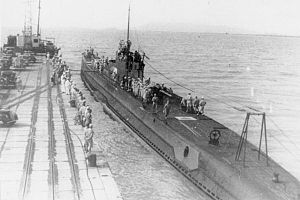
- Submarines: I-10 (with reconnaissance aircraft), I-16, I-18 (damaged and arrived late), I-20
- Midget submarines: M-16b, M-20b
See also
- Force H
- Madagascar in World War II


